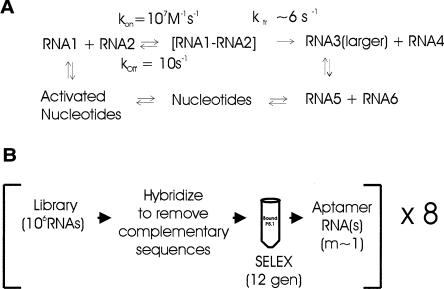FIGURE 1.
(A) Kinetic scheme for recombination during RNA evolution (Schmidt 1999). The rate of interaction between Species 1 and 2, kon, is concentration-dependent and, therefore, depends on the total number of equivalent interacting species. The rate of recombination to produce a larger RNA 3 and smaller RNA 4 depends on the rate of transesterification (Herschlag and Cech 1990; Lawrence and Bartel 2003) within the RNA–RNA complex. If ligation between the ends occurs, the size of RNA 3 would be the sum of those of RNAs 1 and 2. The rate of degradation (Herschlag and Cech 1990) of the active RNA 3 is chain-length dependent. Eventually the RNAs will degrade to nucleotides. The scheme does not take RNA replication into account. (B) Parallel SELEX experiment. Each of eight experiments used an initial library of 106 species, derived by dilution and PCR from an initial pool containing all 420 (~1012) possible 20-mer sequences. All eight libraries had the same 5′ promoter sequence for T7 RNA polymerase; however, the terminal 5 nt of the 3′ were different for each library (Table 1 ▶). This latter attribute prevented cross-contamination of the parallel selections by “parasite” RNAs. The libraries were preselected to remove complementary sequences and selected for the ability to bind column-bound P5.1 RNA. RNAs were reverse-transcribed and cloned after 12 rounds of SELEX.

